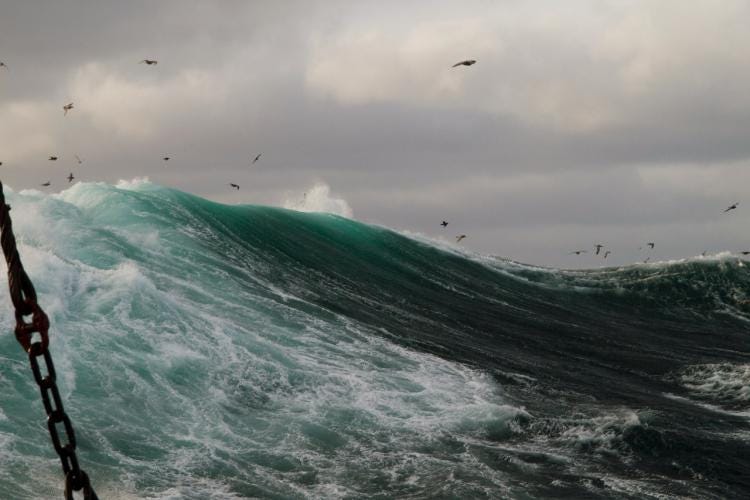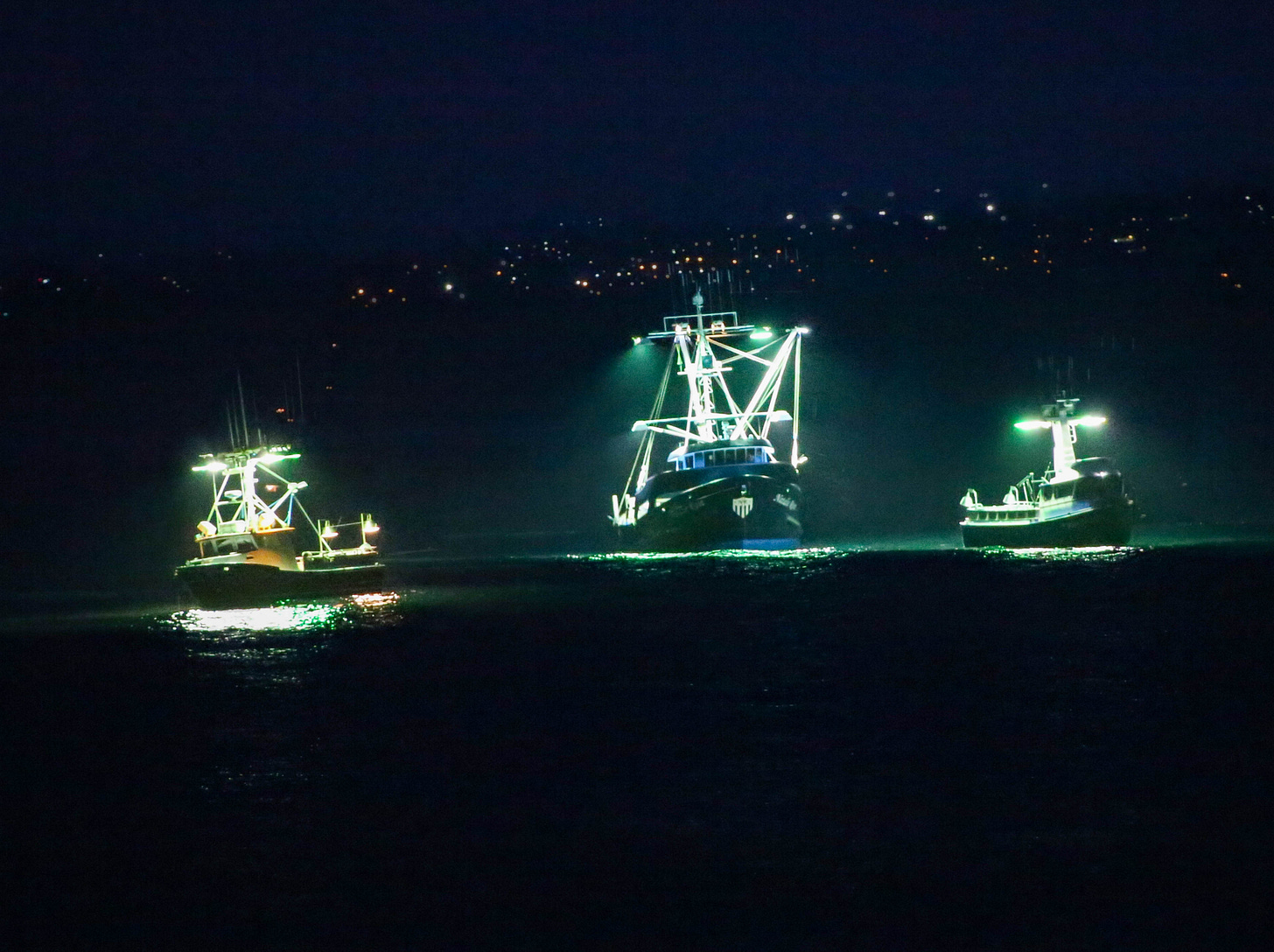Simple climate action // I S S U E #53 // Seafood
Importing the problem
Every year, American boats haul up millions of tons of seafood. Most of it never touches US shores. If it does, it’s usually after traveling across an ocean (or two) on its way to a processor and then the freezer section at your local Tesco or Costco.
Maria Finn chronicles this strange state of affairs this week by exploring the wild world of the international seafood trade. Global markets are often a good thing. In food, they keep prices low, and nutrition abundant. But prices reflect both value and our values. And it’s possible things may be too cheap.
Join us as we examine what it means to be human in the marine food chain.
Michael Coren
The Well-Traveled Squid
Your calamari could have 10,000 miles on it
By Maria Finn
Squid boats float like ghost ships off the Central California coast. Glares of bright light break through the foggy night and spotlights form on the surface of the Monterey Bay. Schools of squid are attracted to light and dart to the surface of the sea where they are easily scooped up with nets. Squid are small, fast-growing, and mature quickly—which makes them a great, down-the-food-chain seafood choice. The fishing method has very little bycatch, unintended species snared in the nets. Squid seems like a great choice.
But there’s a caveat—you might assume that California caught calamari you just ordered is local, especially if you live in California. In truth, it probably has 10,000 miles on it. Virtually all squid caught in California is frozen in large blocks, shipped to China, thawed, cleaned, refrozen, and shipped back. Fresh squid is not chewy—squid frozen twice often is. The same round-trip happens with a lot of Alaskan salmon that ends up in cans. Cost for labor is so much cheaper in China, that even with traveling costs, it saves to have it processed there.
It’s a remarkable trade deficit. Pristine, wild-caught US seafood like wild salmon, black cod, and lobster is shipped and sold abroad, particularly to seafood-loving countries in Asia like Japan and China, where people pay a premium for quality. The US, in exchange, buys huge quantities of cheap seafood, mostly lower-quality farmed Pangasius catfish and tilapia, Ecuadorian shrimp, and Scottish farmed salmon–as well as (re)importing its own catch.
Officially, as much as 90% of the seafood consumed in the United States is imported from overseas. Even after accounting for domestic seafood shipped overseas, processed, and shipped back, the imported share from abroad is still nearly 65%. The reality driving this dynamic is the same: sustainable seafood, particularly shrimp, crab, and finfish, just costs more.
Sustainable fisheries cost the bottom line: boats can’t fish certain seasons, marine protected areas are off-limits, catches must be thrown back (for example, female Dungeness crab can’t be harvested). In some fisheries, boats are required by law to have observers on board to monitor bycatch. The cost, about $500 a day for bottom fish along the West Coast, is borne by the boat.
For years, America’s waters had few laws. Fishermen caught what they wanted. Regulators….well, there weren’t any. By the 20th century, America’s most famed fisheries had effectively collapsed. Unimaginably vast schools of flounder, cod, haddock, red snapper that shocked early European explorers with their abundance, disappeared. In their place, species’ numbers fell to such low levels, scientists feared they might never replenish themselves.
All that changed after the 1996 Sustainable Fisheries Act, an update to the Magnuson-Stevens Fishery Conservation Act (MSA). For the first time, the US imposed a national standard on its fisheries: stocks had to be healthy, or catches were restricted until scientists determined species had recovered.
Seafood costs rose. But so did fish populations.
While the US accounts for only about 20% of the world’s catch, its new management style has made some of its fisheries among the most sustainable in the world by shutting down the harvest of overfished species, and opening up opportunities for farmed fish to fill the gap. Not every fish species has recovered—New England’s commercial cod fishery may be gone forever. And bycatch-or non-targeted species killed in the West Coast swordfish gillnet fishery ensnare whales and dolphins.
While US fisheries aren’t perfect, they tend to be far better managed than most. For the first time in the modern era, it’s possible humans may learn to live as part of their marine ecosystems. The disruptions of climate change will put that to the test.
The long arm of the law finally reaches the oceans
In 1976, Congress created a 200-mile Economic Exclusive Zone off US coasts. No foreign countries could fish within these limits. The United States then pushed to “Americanize” or strengthen the fishing fleets and their efficiency. They succeeded—and fish stocks collapsed. Anyone who could get a hold of a boat and equipment could go fish. Boats had to travel further and further to find Atlantic swordfish. Nets dragging for West Coast groundfish like rockfish, petrale sole and sand dabs were coming up empty.

The number of fishing boats had exploded. For example, the West Coast ground fishery began to expand in 1987 and ballooned to hit 11,000 vessels by 2000. (Currently, there are 120 boats in the fishery). There were fewer and fewer deep-dwelling fish like rockfish, petrale sole, and sand dabs for them to scoop up. That was the year the federal government declared the coast of Oregon, Washington, and California an “economic disaster” due to groundfish stocks collapsing. According to the MSA, it had to be strictly regulated until stocks were healthy again.
Things really changed with the 1996 Sustainable Fisheries Act, an amendment to the MSA. It essentially ordered limits on catches until the fish populations had rebounded within ten years based on scientific data. When fisheries were shut down or severely limited, a gap in the market occurred - and inexpensive, imported farmed fish started filling the gap. Instead of local rockfish, people ate tilapia brought in from China. Farmed seafood, unlike the wild, can be consistently bought by chefs year-round and at a lower price.
For a time, it seemed like America’s coastal abundance was gone forever. Atlantic cod used to be so abundant people scooped them from the sea with baskets. “If ever a fish were made to endure, it is the Atlantic cod,” praised author Mark Kurlansky in his book Cod. “But it has among its predators man, an open-mouthed species greedier than the cod." It’s difficult to bring back a market that has been exhausted, and even more difficult to bring back a species that has been overfished.

Yet, for the most part, the MSA has been a resounding success in the United States. Since 2000, the percentage of stocks that were being overfished has dropped by 63%. Over time, U.S. fisheries became more sustainable—populations were growing or stable, despite catches.
Things seemed to be improving. Then climate change threw everything back up in the air.
Fisheries policy for the climate era
The ocean is dynamic. In the best of times, uncertainty and surprises transform ecosystems. With climate change, more unknowns are appearing. Species are moving out of their usual habitat, often migrating northward towards cooler waters. There are large algae blobs, like the one that appeared off the West Coast in 2015 contaminating shellfish and bivalves with toxins. Storms systems are changing, bringing stronger and more frequent hurricanes, drought and increased temperatures impact fish that migrate to rivers. Due to rising temperatures, kelp forests, important habitats for fish, are dying off, as are coral reefs.
“Climate change will manifest differently in all the systems,” says Corey Ridings, an ecologist at the Ocean Conservancy who has begun studying for his doctorate at the University of Washington. “The unknowns will be happening faster, and will impact our current system more than we are used to.”
Unfortunately, there’s no silver bullet policy. Once a decade, Congress reviews and updates the MSA. Reauthorization updates bills to address new needs, and allocates funding to implement legislation. The most recent reauthorization has been in the works since 2016—and climate change is the core topic of discussion in the fisheries world.
California representative Jared Huffman traveled the country on a listening tour with stakeholders in eight different regions. Virtually everyone emphasized the impact of climate change. In July 2021, Huffman introduced the Sustaining America’s Fisheries for the Future Act to reauthorize the MSA to increase accountability and transparency, strengthen conservation standards, address climate change, and support fishing communities.
While national legislation is necessary, many solutions, like fisheries, are going to be local. “It will be boring and not sexy, but a thousand small things will need to be continually addressed,” says Ridings. “It's both what we decide to do now, and how we evolve our management to be more adaptive for the future.”
Ecosystem-based eating
Corey, who serves on the Pacific Fisheries Council, is working to help usher in a more responsive way of managing fisheries known as Ecosystem-Based Fisheries Management, “a way of thinking about the ecosystem as a whole instead of managing each part in isolation.”
Instead of counting the number of one (targeted) species and declaring it healthy, this approach assesses the health of the ecosystems as a whole. Take the pollock fishery in Alaska. By conventional standards, is a sustainable one that supports a robust fish population. Last year marked the 15th annual certification by the Marine Stewardship Council (MSC), a global nonprofit, with one the highest sustainability scores of any MSC-certified fishery.
But it’s controversial, to say the least. The pollock fishery in Alaska throws out millions of pounds of halibut (a groundfish) as bycatch each year, more than the quota that the halibut fleet is allowed to catch. They also throw out tons of salmon as bycatch. Although catches are stable, that’s lead to a decline in northern fur seals that rely on pollock as a primary food source. Indigenous people in the area who rely on seals, salmon and halibut for their subsistence have also seen their hunting and fishing success decline.
From an ecosystem perspective, as Corey sees it, pollock are a less sustainable fishery than the numbers might suggest at first blush.
Next week, we’ll explore a new way humans can become ecosystem-based eaters as part of the ocean’s food web. “We have to ask what is important to us,” says Ridings. “What are our values? And eat local fish.”

Like what you’re reading? Share Hothouse with a friend (or many)!
Hothouse is a weekly climate action newsletter edited by Mike Coren and Cadence Bambenek. We rely on readers to support us, and everything we publish is free to read.









